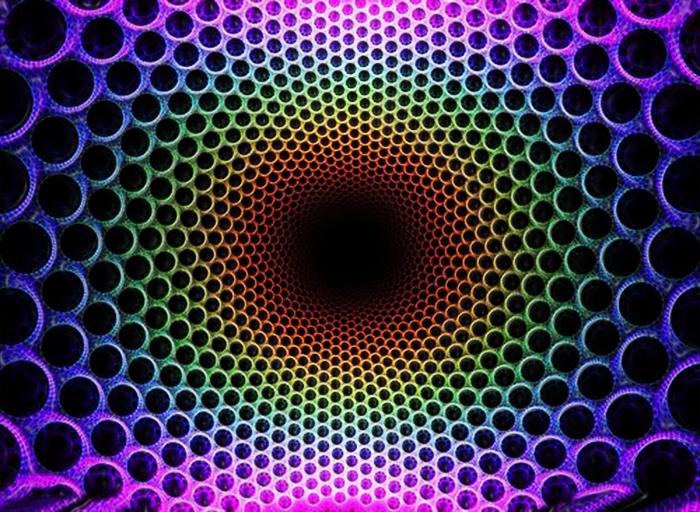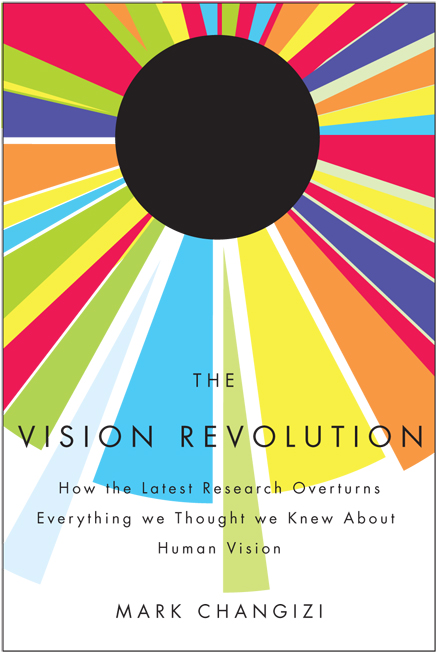Review: The Vision Revolution

“Why do we see in color? Why do our eyes face forward? Why do we see illusions? Why are letters shaped the way they are?”
Intriguing riddles such as these often necessitate interdisciplinary brilliance to solve. Theoretical biologist and neuroscientist Mark Changizi has been stockpiling research in these areas for much of the last decade, fixated on some of the fascinating but imperfectly understood precincts of human perception. Not content with asking how our central nervous system functions, Changizi is determined to provide explanations of why its architecture and inter-operative functionality exist as they do. The Vision Revolution, should it withstand the scrutiny of peer review, is a groundbreaking work in vision science that brings forward original research into the evolution of the human visual system.
In the book he pivots between four core ideas, each of which are given mystical titles:
(1) Color telepathy: “Color vision was selected for so that we might see emotions and other states on the skin.”
(2) X-ray vision: “Forward-facing eyes were selected for so we could use X-ray vision in cluttered environments.”
(3) Future-seeing: “Optical illusions are a consequence of the future-seeing power selected for so that we might perceive the present.”
(4) Spirit-reading: “Letters culturally evolved into shapes that look like things in nature because nature is what we have evolved to be good at seeing.”
Each entrée of this technical collation is truly mind-altering, and it is a joy to tag along as Mark architects the empirical struts of his developmental theses. Let’s dive right in.
Color Vision
His first course of business is to provide an alternate explanation of the origin of color vision in primates. While we take it for granted today, color sensing is a relatively recent adaptation in the mammalian order. Until now, the default view among vision scientists is that color was selected for to distinguish between various types of fruit and leaves. The regnant explanation has survival value on its side, but Changizi believes it is not the complete answer. After all, not all mammalian diets are alike, but our color sensors and attendant properties are strikingly continuous with other color-sensitive primates.
Changizi instead makes the case that color acuity evolved to detect changes in skin oxygenation. When blood and oxygen levels fluctuate, we see an instant feedback effect on our skin. These shifts in skin tone and color signal us to changes in mood and emotion states and, more importantly, alert us to physiological dysfunction. A mother who can sense the full range of hue, saturation and brightness deviations in her baby’s face and body is in a better position to detect when something is amiss and take proper action.
This hypothesis puzzles out well enough for bare-skinned animals like humans, but what about hairy primates – the ancestors which supposedly evolved these traits long before our debut? It turns out there is a neatly correlated distribution between color vision and bare-faced primates. Changizi surveys the animal kingdom and finds that primates lacking color vision have furry faces, while those with hairless spots on their faces and body tend to have color vision just like us. He notes that this more “fleshed-out” explanation does not swear mutual exclusivity with the dominant explanation; indeed, they could be co-occurring drivers of selection.
X-ray Vision
Have you ever wondered why we have forward-facing eyes, as opposed to sideways-facing eyes like most reptiles, birds and fish? As Changizi demonstrates, this element of our physiology was selected for to better suit the habitat in which our ancestors evolved. This might at first seem like a non-intuitive proposition, as surely our survival would be better served by the ability to see both in front of and behind us (as animals with sideways-facing eyes most certainly can). But there’s a more marvelous, some might say superhuman reason our current orientation was favored.
Close one of your eyes. Notice how your nose is suddenly visible. The result is the same when you close your other eye. With both eyes open, however, the portion of your visual field occupied by your nose is no longer blocked. You are, effectively, able to see through your nose. Remarkably, this trick can be reproduced with any object whose width is narrower than the width of your eyes. Hold up your hand, position it vertically in front of your face, and you can see through it to read the screen behind it.
According to Changizi, this ability was helpful in leafy habitats, enabling our predecessors to see through grass and other foliage to spot predators and food. As life transitioned from water to land, those acclimatizing to heavily verdant environments gradually evolved the optical design shared by humans today. The binocular region for animals with sideways-facing eyes, on the other hand, is far too narrow to be effective, explaining why this arrangement is less commonly found in lush surrounds. While we may be manifestly less dependent on this feature today, it is nonetheless fascinating that evolution has gifted us with a passive form of X-ray vision.
Optical Illusions (and why they trick us)
As we move into the book’s third unit, we listen in as Changizi disassembles the aura of visual illusions. It’s estimated that eyes first evolved around 500 million years ago. Why then, after all this time, aren’t our eyes and brains complex enough to avoid being fooled by simple visual tomfoolery? Shouldn’t we process these images correctly by now?
The answer lies in the communication protocols linking our optical and brain arrays. The deep relationships governing the brain and the eye help us function appropriately in a three-dimensional world. The architecture of our central nervous system is such that a gap of 1/10th of a second exists between the moment light first hits our photoreceptors and when that signal is processed by the brain. Our brain then compensates for this delay by projecting images 1/10th of a second into the future.
These premonitions aid us in catching a thrown ball, for example, but can trick our senses when viewing static imagery on a two-dimensional plane. In effect, our in-built neural lag causes us to intuit motion-like characteristics to inert images, per the example above. Alas, our future-seeing ability is too favorable to our survival to ever part with, so the minor bug of awkwardly processing 2D geometry will remain an acceptable trade-off.
Nature’s Alphabet
“Spirit-reading” is Changizi’s nimble way of referring to all of the knowledge, thoughts and ideas nesting in the world’s books, literature and other written material. Thanks to language and writing, we have the ability to peer into the minds of our ancestors. And what an uncanny ability it is! Written language is not a technology we could have guaranteed would mesh well with our biology. So how did it come about? And why was it such a glowing success?
Changizi seeks to explain the contagion of written communication by linking its design to the shapes and contours found in our natural environment. If the basic strokes, junctions, marks and symbols of writing were adapted from familiar objects in nature, then our streamlined visual system would be well-prepared to process this information effectively. In fact, if we rewind the clock to our most ancient writing systems, we find they are unmistakably logographic (object-like), including Sumerian cuneiform (the very first writing system ever developed organically ~3200 BCE), Egyptian hieroglyphs, Chinese characters, and the independently derived writing of the Mexican Indians appearing sometime before 600 BCE.
Through some involved visual linguistic analysis, Changizi submits that the fundamental structures of letters are akin to object parts observed in nature. The more common configurations we find in nature tend to find prevalence in human writing schemes. This relationship was no accident; our ancestors mimicked natural scenery to optimize information retrieval through the instrument of writing. In this sense, the clues to writing’s triumph are lurking in the letters themselves.
Closing Thoughts
There should be more books like The Vision Revolution. Changizi presents a highly compelling, evolutionarily grounded case for four intriguing ideas, distills the related focus areas into readable prose, and tailors it to the nonspecialist. The abundance of visual aids is a thrilling, effective way to convey his ideas and goes a long way toward making this more engaging than the average non-fiction work. The Vision Revolution is concise, well-argued, easy to wade through, and comes enthusiastically recommended. These ideas will change the way we think about vision and our perception of the world, and I hope it spawns even more exciting research going forward.
Note: This review is mirrored over at Goodreads and at Amazon.




Comments